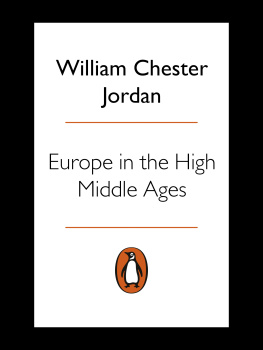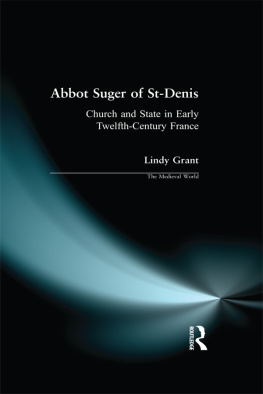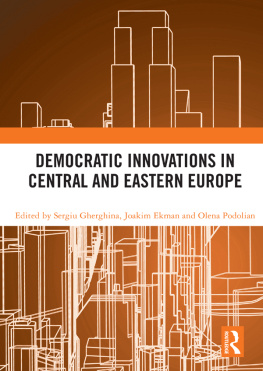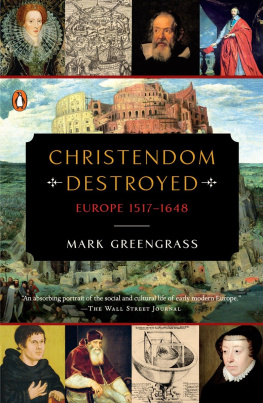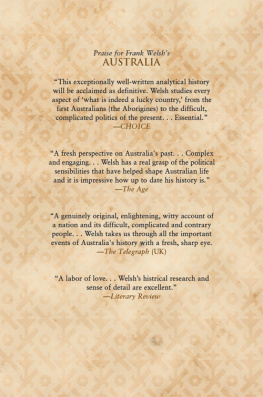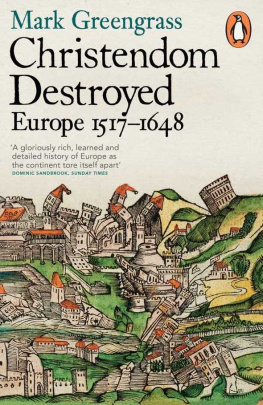PENGUIN BOOKS
THE PENGUIN HISTORY OF EUROPE
GENERAL EDITOR: DAVID CANNADINE
EUROPE IN THE HIGH MIDDLE AGES
William Chester Jordan, former Director of the Shelby Cullom Davis Center for Historical Studies (19949), is Professor of History and Director of the Program in Medieval Studies at Princeton University. He is the author of The Great Famine: Northern Europe in the Early Fourteenth Century, which won the Haskins Medal of the Medieval Academy of America in 2000.
THE PENGUIN HISTORY OF EUROPE
I: SIMON PRICE Classical Europe
II: CHRISTOPHER WICKHAM Early Medieval Europe
III: WILLIAM JORDAN Europe in the High Middle Ages
IV: ANTHONY GRAFTON Renaissance Europe, 13501517
V: MARK GREENGRASS Reformation Europe, 15151648
VI: TIM BLANNING The Pursuit of Glory: Europe 16481815
VII: RICHARD J. EVANS Europe 18151914
VIII: IAN KERSHAW Twentieth-Century Europe
already published
WILLIAM CHESTER JORDAN
Europe in the High Middle Ages

PENGUIN BOOKS
PENGUIN BOOKS
Published by the Penguin Group
Penguin Books Ltd, 80 Strand, London WC2R 0RL , England
Penguin Group (USA), Inc., 375 Hudson Street, New York, New York 10014, USA
Penguin Group (Canada), 90 Eglinton Avenue East, Suite 700, Toronto, Ontario, Canada M4P 2Y3
(a division of Pearson Penguin Canada Inc.)
Penguin Ireland, 25 St Stephens Green, Dublin 2, Ireland
(a division of Penguin Books Ltd)
Penguin Group (Australia), 250 Camberwell Road, Camberwell, Victoria 3124, Australia
(a division of Pearson Australia Group Pty Ltd)
Penguin Books India Pvt Ltd, 11 Community Centre, Panchsheel Park, New Delhi 110 017, India
Penguin Group (NZ), 67 Apollo Drive, Rosedale, North Shore 0632, New Zealand
(a division of Pearson New Zealand Ltd)
Penguin Books (South Africa) (Pty) Ltd, 24 Sturdee Avenue, Rosebank, Johannesburg 2196, South Africa
Penguin Books Ltd, Registered Offices: 80 Strand, London WC2R 0RL , England
www.penguin.com
First published by Allen Lane 2001
Published in Penguin Books 2002
9
Copyright William Chester Jordan, 2001
All rights reserved
The moral right of the author has been asserted
ISBN: 978-0-14-193572-0
Contents
9. Cultural Innovations of the Twelfth Century:
Vernacular Literature and Architecture
List of Illustrations
(Photographic acknowledgements are given in parentheses)
San Bartolomeo, Pantano, Pistoia, Italy. (Photo: Scala)
Basilica of San Pietro, Moissac, Italy. (Photo: Scala)
Autun Cathedral, France (Photo: Corbis)
Durham Cathedral, England. (Photo: Scala)
Basilica of Vzelay, France. (Photo: Ludovic Maisant/Corbis)
San Millan, Castile, Spain. (Photo: A.I.S.A.)
Basilica of Vzelay, France. (Photo: Scala)
Rose window, Chartres Cathedral, Notre Dame, Paris. (Photo: Corbis)
Gothic reliquary (National Gallery, Perugia, Italy) (Photo: Scala)
Notre Dame, Paris, France (Photo: Scala)
Bourges Cathedral, France. (Photo: Scala)
World map, c. 1250 (Ms.Add.2861, fol.9, British Library, London). (Photo: AKG London)
Krak des Chevaliers, Syria, c. 1142. (Photo: AKG London)
Sainte-Chapelle, Paris. (Photo: Scala)
Bourges Cathedral, France. (Photo: AKG London/Eric Lessing)
Burgos Cathedral, Spain. (Photo: Scala)
Westminster Abbey, London. (Photo: AKG London/Robert ODea)
Tournai Cathedral, Belgium. (Photo: Hutchison Library/Bernard Regent)
Wells Cathedral, England. (Photo: Scala)
Virgin and Child, by Giovanni Pisano, Pisa, Italy. (Photo: Scala)
Abraham and the Three Angels from the St Louis Psalter. (Biblioteque Nationale de France). (Photo: The Bridgeman Art Library)
Vignette from a Gothic manuscript (Santa Croce, Florence, Italy). (Photo Scala)
King Solomon, from the Arsenal Bible (Ms.5211, fol.307, Biblioteque de lArsenal, Paris/Biblioteque Nationale de France).
Crucifixion (Museum of Catalan Art, Barcelona). (Photo: Scala)
Lewd marginalia from Le Voex du Paan (Ms.24, fol.25v, Pierpont Library, New York). (Photo: Scala)
List of Maps
Europe
Mediterranean Europe in the eleventh century
Northern Europe in the eleventh century
France in the eleventh century
Central Europe in the eleventh century
The First Crusade
Northern Europe in the twelfth century
Southern Europe (including Crusader States) in the twelfth century
The Fourth Crusade
England and France in the twelfth century
Scandinavia, Germany, Hungary and the Slavic lands in the thirteenth century
Later crusades
Acknowledgements
I wish to thank David Cannadine, the editor of the series, for inviting me to contribute the volume on the High Middle Ages. Ravindra Mirchandani, the original editor of the series at Penguin Press, was helpful in getting me started on the project. Simon Winder, who took his place, struck me from the first as a judicious and considerate person, one whom, I felt, I did not wish to disappoint, either by writing an entirely traditional book or being very late in completing it. In Princeton, Tina Enhoffer served as my research assistant, but she also read and assessed the individual chapters. Dr Adam Davis assembled the list of Suggested Reading. My colleagues Arno Mayer and Peter Brown gave me the benefit of their learned criticisms and suggestions, with regard to both style and content. I owe them a profound debt of gratitude.
I dedicate this book to the memory of my beloved sister, Ellen Marie.
Note on Names
Whenever possible I have adopted the usages of the Dictionary of the Middle Ages, ed. Joseph R. Strayer, 13 volumes (New York, 19821989) for personal and place names. In those relatively few instances where a person or place mentioned in this book does not appear in the Dictionary or where its usages seem idiosyncratic, I have adopted what I take to be the most common or sensible spelling in English-language texts.
Prologue
The forty-seven-year-old Alsatian pilgrim, Bruno of Egisheim, who made his way more than 600 miles from Worms to Rome in 1049, had only recently become Pope Leo IX. In the cortege with this future saint, canonized in 1087, was a group of earnest and purposeful companions, including Abbot Hugh of Cluny and a still little-known Tuscan monk by the name of Hildebrand. These men and a few others like them had a conception of the universal Church and of a universal Christian society (Christendom) that they would impose imperfectly but in grimly determined stages and with enormous consequences on the princes and bishops of the Catholic faithful. In the person of the new pope, the conception was revealed principally through his unceasing efforts to eradicate simony, the purchase of ecclesiastical offices, a practice that placed local churches under the control of influential families and, thereby, permitted aristocrats of the period to exploit and impoverish local churches or to use them as pawns in their feuds.
The Frenchman Hugh of Clunys contribution lay in the creation of a network of loyalties that transcended local ties. Under his abbacy, the great Burgundian abbey of Cluny became the pre-eminent monastic institution in the West, with innumerable daughter houses founded directly by its monks and with numerous other more ancient houses either reformed by its monks or inspired by the compelling Cluniac model to undertake their own reforms in close communion with it. From the magnificent church that he built at Cluny, the largest in Christendom until the Renaissance, St Hugh (he too would be canonized) helped to guide the fortunes of monks from Britain to Spain, and his prestige was such that princes and churchmen all over Catholic Europe begged his counsel and instruction.
Next page
